
Art Gharana — 11 Mins read
The Role of Kathak in Indian Festivals and Celebrations
Kathak
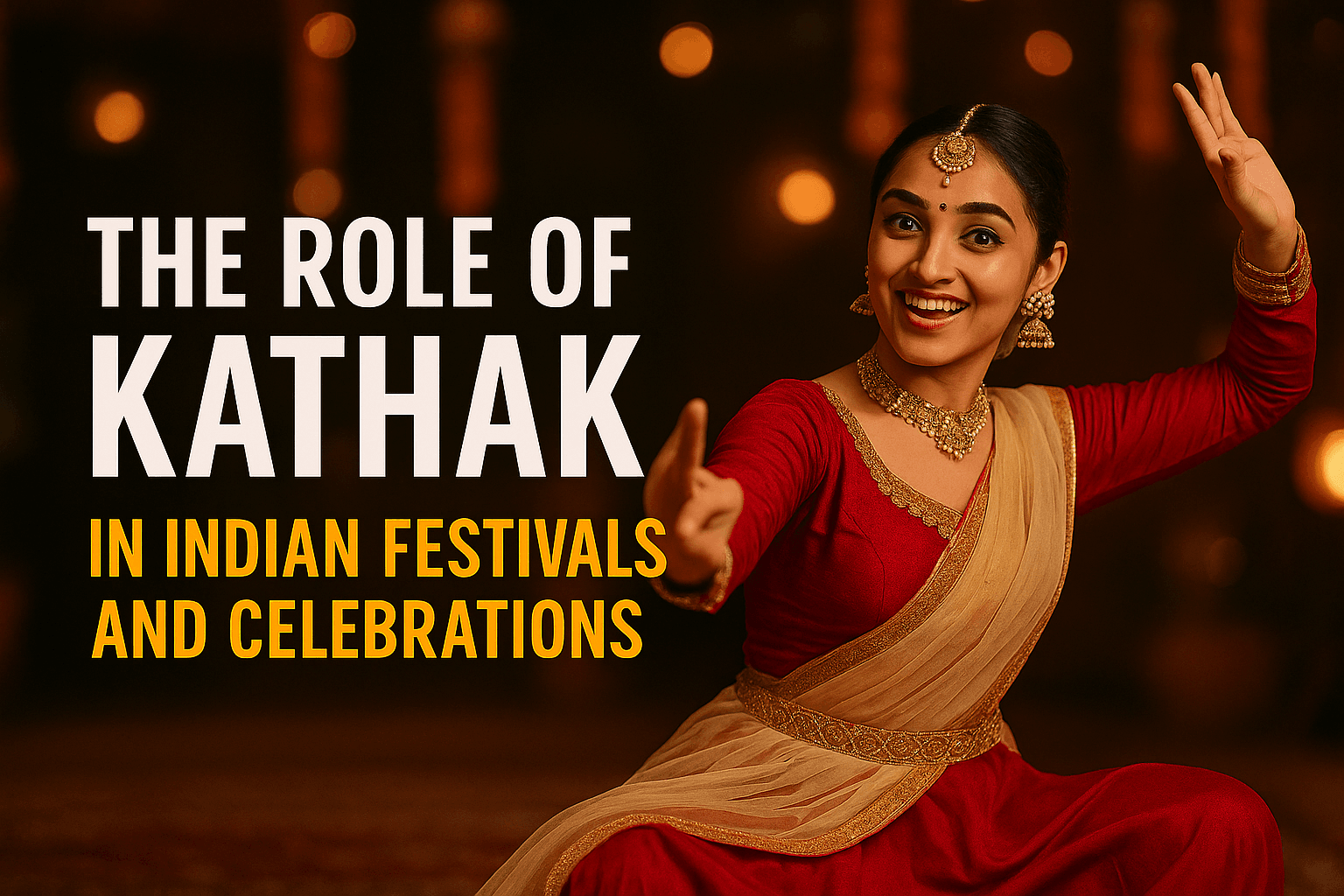 Have you ever wondered how ancient dance forms continue to breathe life into modern-day festivals? In India, where every celebration is steeped in tradition, Kathak stands out as more than just a performance—it's a powerful form of storytelling that bridges the sacred and the social. Whether it’s the rhythmic footwork echoing in temples during Janmashtami, or the vibrant expressions on community stages during Diwali and Navratri, Kathak brings depth, grace, and emotion to our cultural festivities.
Have you ever wondered how ancient dance forms continue to breathe life into modern-day festivals? In India, where every celebration is steeped in tradition, Kathak stands out as more than just a performance—it's a powerful form of storytelling that bridges the sacred and the social. Whether it’s the rhythmic footwork echoing in temples during Janmashtami, or the vibrant expressions on community stages during Diwali and Navratri, Kathak brings depth, grace, and emotion to our cultural festivities.
Rooted in centuries of spiritual and artistic heritage, Indian classical dance Kathak has evolved beautifully, finding its place not only in temples and royal courts but also in today’s virtual Kathak lessons and global festivals. If you’ve ever watched a dancer’s swift pirouette or expressive hand gestures and felt moved without understanding the language—then you’ve already experienced Kathak’s universal magic.
In this blog, we’ll explore how Kathak enriches Indian festivals and celebrations, why it’s still relevant in the digital age, and how you, too, can become part of this living tradition. Whether you're a cultural enthusiast, a curious learner, or someone searching for Kathak dance for beginners online, there’s something meaningful waiting for you in every beat and gesture.
Let’s dive into the rhythm, the rituals, and the remarkable journey of Kathak in celebrations across India—and beyond.
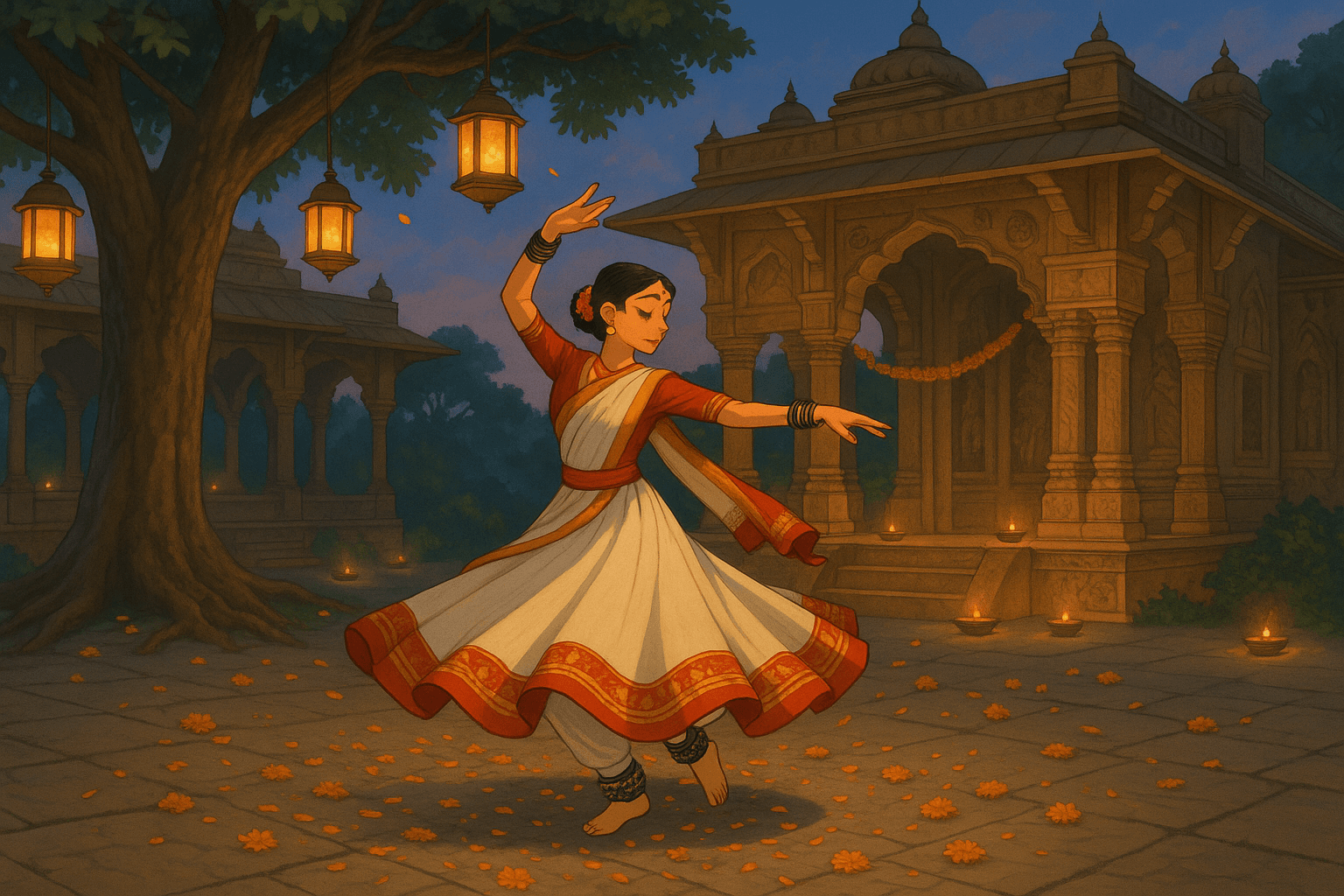
What makes Kathak more than just a dance form? To truly appreciate its role in Indian festivals and celebrations, we must first explore the cultural soil from which it bloomed. Kathak is not just about graceful spins and rhythmic footwork—it's a centuries-old tradition of storytelling, devotion, and heritage that continues to evolve with time.
Originating in the northern regions of India, Kathak began as a form of devotional expression by itinerant bards known as "Kathakars" who narrated epics like the Mahabharata and Ramayana through movement and music. These early performances often took place in temples, transforming Indian classical dance Kathak into a spiritual medium. With the passage of time, especially during the Mughal era, Kathak absorbed Persian influences—introducing intricate footwork, elegant costumes, and court-style performance. This unique blend of spiritual and royal aesthetics sets Kathak apart from other classical dances.
To understand Kathak’s role in cultural expression, let’s break down its essence:
These elements make Kathak an ideal narrative vehicle—perfect for depicting festival stories and deities with depth and drama.
Did you know that Kathak has distinct styles known as Gharanas? These include:
1 Lucknow Gharana – Known for its grace and subtle expressions 2 Jaipur Gharana – Celebrated for strong footwork and dynamic spins 3 Banaras Gharana – Recognized for its devotional roots and flowing movements
Each Gharana contributes a unique flavour to festival performances, often shaping how certain mythological tales are portrayed.
Understanding these cultural roots isn’t just academic—it shapes how we experience and perform Kathak today, whether on stage or online. If you’re someone looking to connect with tradition through movement, understanding the classical Kathak training lineage gives you a deeper sense of purpose and pride in every step.
Thinking of beginning your own journey? Discover how you can learn from home with Online Kathak Dance Classes designed for all levels, including beginners.
Kathak is not just learned; it’s lived. And every time it graces a festival stage, it carries generations of culture with it—making each performance a living piece of history.
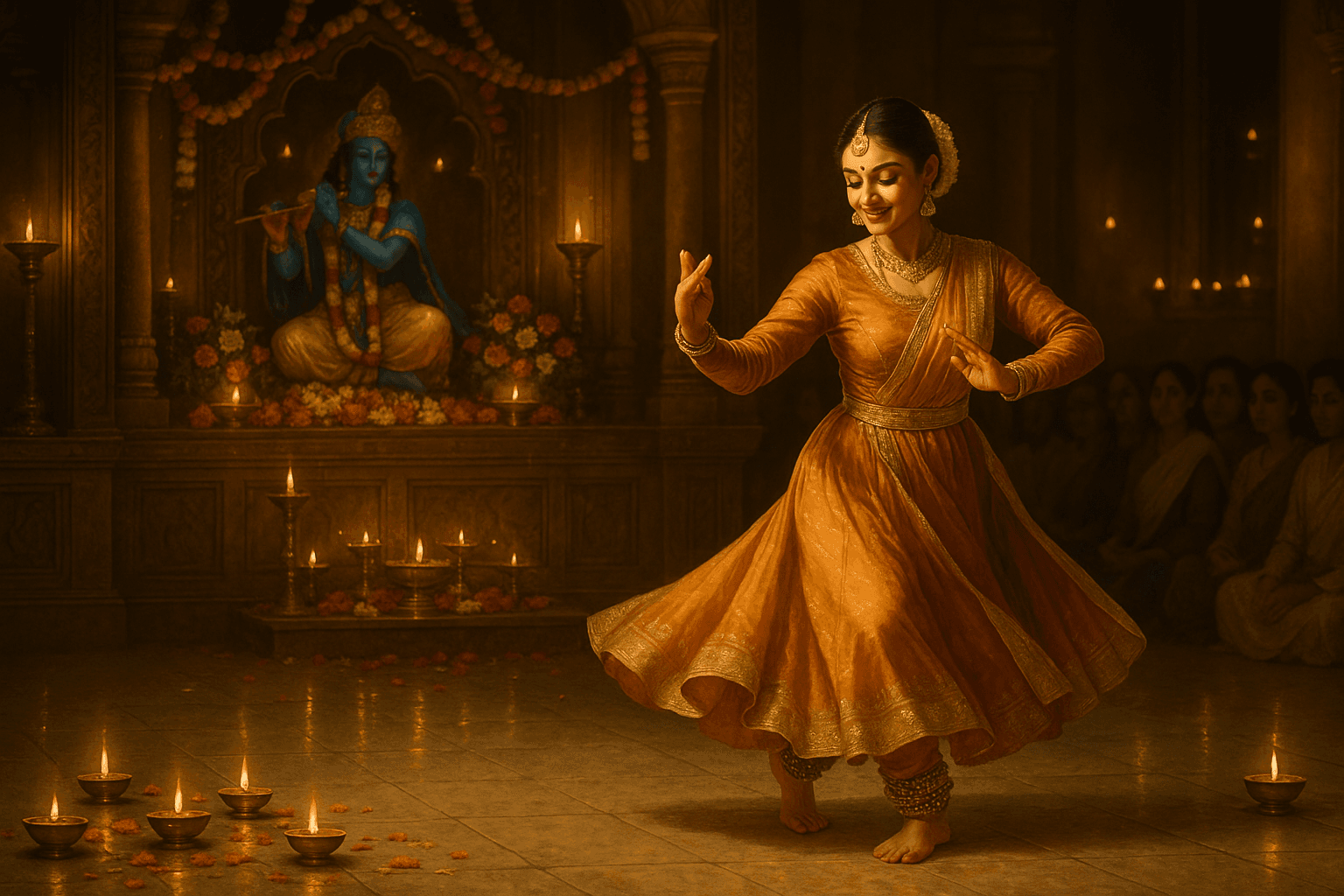
Have you ever noticed how deeply Kathak is intertwined with devotion? Long before it dazzled audiences on modern stages, Kathak began as a sacred offering—an expressive medium to honor the divine during religious festivals. Today, even as it adapts to online Kathak dance classes and digital platforms, the spiritual essence of Kathak continues to pulse at the heart of its most powerful performances.
In its earliest form, Kathak was performed in temples as a devotional storytelling dance. Through expressive movements and symbolic gestures, dancers would narrate episodes from the lives of deities like Krishna and Rama. This made Kathak not just an art form, but an act of bhakti (devotion).
Especially during festivals like:
In these moments, the dancer becomes more than a performer—they become a storyteller, a devotee, and a channel for spiritual energy.
A core part of Kathak’s spiritual power lies in Abhinaya, the art of conveying emotion. Whether it’s joy, longing, surrender, or love, dancers use subtle facial expressions and delicate hand gestures to bring stories to life.
Why does this matter in festivals? Because it allows audiences—not just to watch—but to feel. It turns a cultural event into an intimate, emotional experience, resonating with people of all ages and backgrounds.
The music that accompanies Kathak performances—tabla, harmonium, vocals, and manjira—is often based on classical bhajans and devotional compositions. The rhythmic cycles (taals) used are deeply spiritual, connecting dancers to the heartbeat of tradition.
Dancers prepare not just physically, but spiritually:
These rituals align Kathak with the sacredness of the festivals themselves.
Thanks to platforms offering virtual Kathak lessons, the spiritual legacy of Kathak is reaching devotees and learners across the globe. Whether you're in Canada, the UK, or Australia, you can now learn how to perform Kathak dance for beginners online, and take part in celebrating Indian festivals from anywhere in the world.
Want to honor tradition from your living room? Book a Free Trial Class and start your journey into spiritual expression through dance.
Kathak in festivals isn’t just about art—it’s about connecting the body, mind, and soul to a higher purpose. Every spin, every beat, every glance is a sacred offering. And whether you're a viewer or a dancer, you become part of something timeless.
How often do you witness a Kathak performance that instantly transforms a community gathering into something magical? Whether it's a local Diwali celebration or a vibrant Holi event in your neighborhood park, Kathak brings color, rhythm, and grace to public festivities—uniting people through shared stories and cultural pride.
Beyond temples and spiritual settings, Indian classical dance Kathak has become a cultural ambassador, taking center stage at festivals, melas, school functions, and diaspora events across the world.
From the first beat of the tabla to the final whirl of the chakkar, Kathak performances are often the most anticipated part of any community event. Here's why:
Across India and around the world, Kathak performances are woven into:
Each of these celebrations uses Kathak to elevate the festive spirit, adding emotional resonance and traditional authenticity.
Kathak isn't just performed—it's shared. In community settings, it becomes a collaborative experience:
This inclusiveness makes Kathak dance classes more than a skill—they become a platform for belonging.
Want to be part of this cultural movement? Explore our Online Kathak Classes and learn how to perform confidently at community festivals.
With the rise of online Kathak dance classes, learners from all corners of the world are preparing to take part in cultural events—bringing their heritage to life at schools, auditoriums, and digital showcases.
Whether you're celebrating Holi in Houston or Diwali in Sydney, your Kathak performance is more than a dance—it's a statement of identity, pride, and cultural connection.
Kathak’s presence in community events reminds us that tradition isn’t confined to the past—it’s alive, evolving, and waiting for you to take the stage.
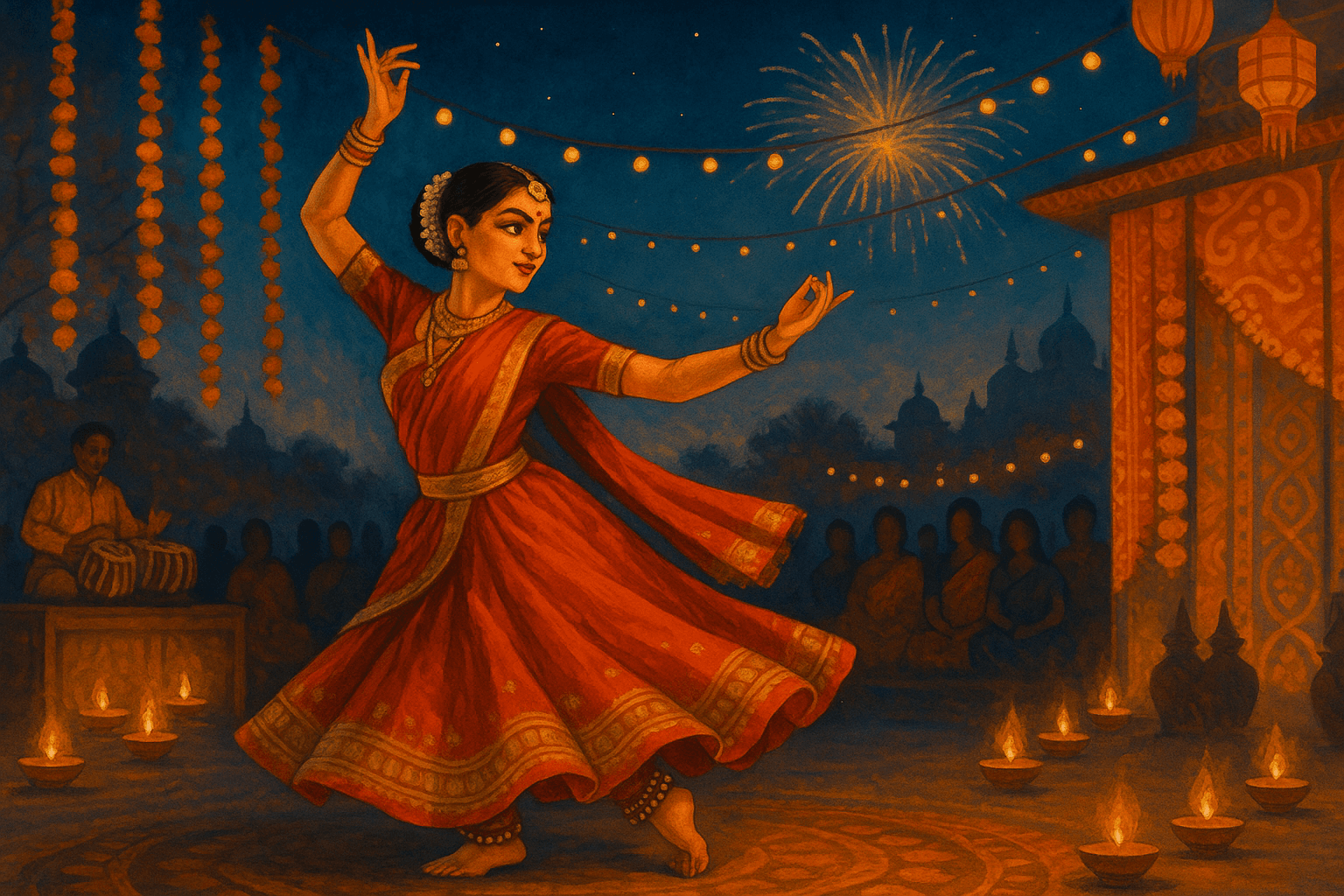
What is it about Kathak that moves people—even those unfamiliar with its origins or structure? The answer lies in its emotional power. When Kathak graces a festival stage, it’s not just a performance—it becomes an experience that resonates deeply with the audience, connecting hearts, communities, and cultures in profound ways.
Festivals are about joy, tradition, and togetherness. Kathak embodies all three, offering a shared language of expression that transcends age, background, and even borders. Here’s how:
Whether it’s a young girl performing at her first Diwali function, or a group of diaspora artists bringing Kathak to life in a Toronto community center, these moments leave a lasting impression—not just on stage, but in the hearts of everyone watching.
One of the most beautiful aspects of Kathak dance classes—especially during festive seasons—is the way they bring people together. Parents attend their children's rehearsals. Siblings join practice sessions. Neighbors gather to help with costumes or stage setup.
This kind of communal effort fosters:
1 Stronger family ties through shared goals and traditions 2 Local cultural awareness, especially among children 3 A sense of pride in carrying forward Indian heritage—whether in India or abroad
When you join a Kathak performance, you're not just learning steps—you’re weaving your story into your family and community's cultural fabric.
Kathak has long been a channel for self-expression, and that role is even more powerful today. For many young dancers—especially women—it offers:
Enrolling in Kathak dance for beginners online can be the start of a transformative journey, especially for young learners growing up outside India.
Thinking of giving your child or yourself this cultural gift? Explore our Online Kathak Classes or Book a Free Trial Class today.
At its heart, Kathak is about evoking rasa—the emotional essence of life. It captures joy, sorrow, devotion, and love through every turn, glance, and beat. During festivals, these emotions are magnified. A well-executed Kathak piece doesn’t just entertain—it elevates the entire celebration, inviting everyone to reflect, rejoice, and reconnect.
So the next time you see a Kathak dancer on a festival stage—or become one yourself—know that you're taking part in something deeper than just performance. You're helping to sustain a legacy that unites, empowers, and inspires.
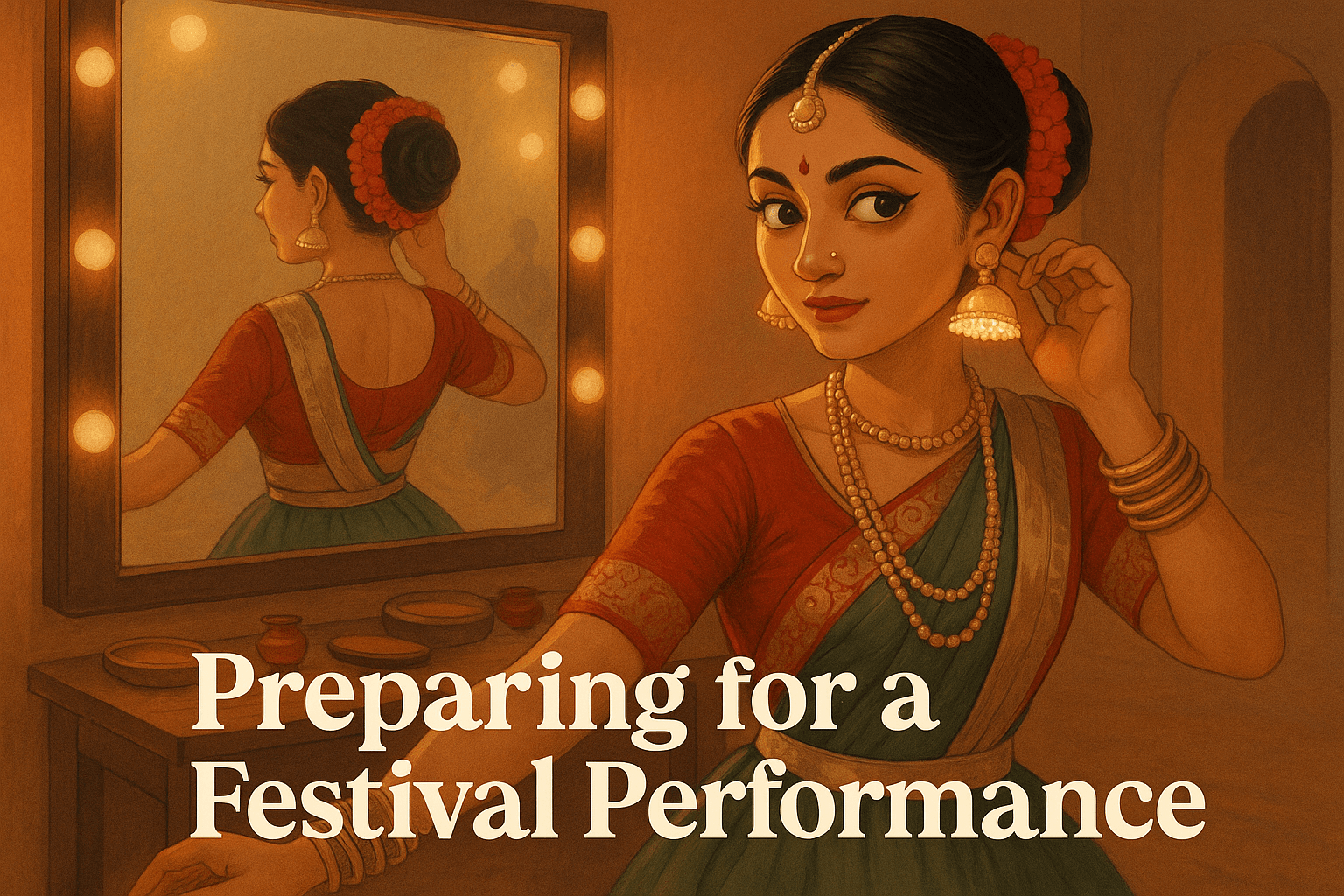 Ever watched a Kathak dancer light up the stage during a festival and wondered—how do they make it look so effortless? Behind the elegance lies intense preparation, discipline, and passion. Whether you’re a beginner or someone aspiring to perform at a cultural event, understanding the process can be both inspiring and useful.
Ever watched a Kathak dancer light up the stage during a festival and wondered—how do they make it look so effortless? Behind the elegance lies intense preparation, discipline, and passion. Whether you’re a beginner or someone aspiring to perform at a cultural event, understanding the process can be both inspiring and useful.
This section is your backstage pass into what it takes to prepare for a stunning Kathak performance, especially during festivals.
Before you even choose a costume or song, the journey begins with classical Kathak training. This lays the foundation for everything that follows—technique, expression, rhythm, and poise.
If you can’t access in-person classes, don’t worry. Online Kathak dance classes now offer:
Ready to begin your prep? Book a Free Trial Class and step into the world of Kathak from your home.
Practice isn’t just about getting the steps right—it’s about building confidence and creating an emotional connection with your piece. Here’s how dancers typically prepare:
1 Break the choreography into sections for easier memorization 2 Use video feedback to fine-tune hand gestures and expressions 3 Rehearse in costume to adapt to the attire and ghungroos 4 Train with live music or recordings to internalize rhythm (taal) 5 Practice Abhinaya (expressions) in front of a mirror to convey emotion
Just like a puja, rehearsals before a festival are sacred—each repetition brings you closer to artistic clarity and emotional depth.
Festival performances call for traditional attire that reflects the story and the deity being honored. The look isn’t just about beauty—it’s symbolic.
Remember, presentation is part of the performance. It sets the tone before you even take your first step.
Stage fright is real—even for seasoned dancers. The key lies in transforming anxiety into energy.
Try these strategies:
Festivals are forgiving, joyous spaces. Your goal is to share a story, not deliver a flawless technical performance.
What sets a Kathak performance apart during festivals is the emotional connection. You're not just a dancer—you’re a narrator of devotion, joy, and cultural pride.
Whether you're performing in a temple, at a school Diwali function, or on a virtual platform, bring:
Because that’s what makes your performance unforgettable.
Want to explore how Art Gharana helps students prepare for stage performances across the globe? Visit our Online Kathak Classes or learn more About Us.
With the right training, mindset, and preparation, you can make every Kathak performance at a festival a powerful celebration of both tradition and self-expression. Are you ready to take the stage?
So, what makes Kathak such a timeless companion to Indian festivals and celebrations? It’s more than the sound of ghungroos or the spin of a chakkar. It’s the emotion in each glance, the devotion in every step, and the stories that come alive through graceful movement. Whether performed in temples, community halls, or on virtual stages, Kathak transforms celebrations into soulful experiences that linger long after the final bow.
Today, you don't need to wait for a local class or a guru in your neighborhood to begin your journey. Thanks to the rise of online Kathak dance classes, you can embrace this classical art form from anywhere in the world—be it London, Toronto, Sydney, or New York. And if you're new to this path, starting with Kathak dance for beginners online can open up a world of tradition, rhythm, and personal growth.
Ask yourself:
If your answer is yes to any of these, there’s never been a better time to begin.
Step into tradition with a modern rhythm—Explore Online Kathak Classes or Book a Free Trial Class and begin writing your own story through dance. Kathak isn’t just a part of Indian festivals—it is a celebration in itself. And now, it’s your turn to join the rhythm.